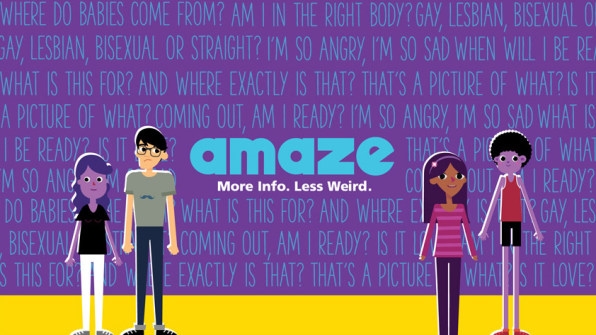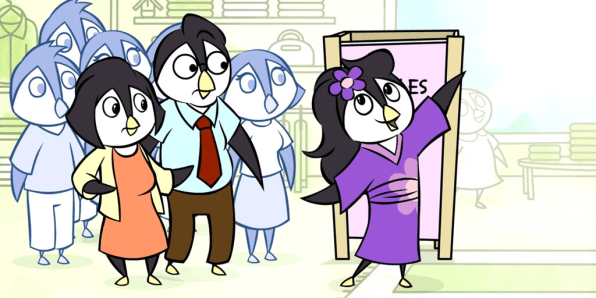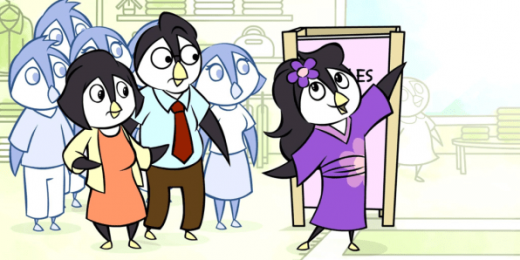These Fun Online Cartoons Give Kids Honest Advice About Sex
In the cartoon, two animated condoms try to go down a pair of side-by-side slides. The first zips down easily, a look of satisfaction on its face, while the second gets stuck and appears disappointed. “Some condoms have lubricant to make them more comfortable during sex, while others do not,” explains a female narrator in a voiceover.
In the next scene, the stuck condom appears to have learned this. It applies its own water-based lubricant and cheers as it continues the ride. “Non-lubricated condoms can be used with water-based lubricants, such as commercial lubricant you can buy in the drug store near the condoms,” adds the narrator. Cue the flashing red Xs that cross out an oil can and Vaseline container, along with a verbal warning that Vaseline or other oil-based lubricants should always be avoided because they break down the condom.
The same balance of humorous imagery and important information happens throughout the three-minute episode, which covers the entire act of sex, from safely opening and putting on a condom, to consummating the act and cleaning up afterward. But that video, entitled “How To Use The Contraception Effectively,” is one of over 50 that are now freely available online at AMAZE, a YouTube-based sexual education program that has more than 5 million views.
It took a team of health nonprofits to make this happen. Advocates for Youth, Answer, and Youth Tech Health combined forces to launch the venture in October 2016. Their efforts are supported by the WestWind Foundation, which works globally to improve future generations’ quality of life through environmental protection and better access to reproductive health services. In April 2018, AMAZE released a Spanish-language version to reach more kids in Latin American countries.

WestWind conceived of AMAZE as a supplemental resource for kids with questions that go beyond those being addressed in their classroom sexual education programs. After all, when kids go online to learn about sex, they often find porn, which doesn’t model healthy sexual behaviors. But as the current administration has continued to express support for an abstinence-only class curriculum–the political code word is “sexual risk avoidance”–and pushed to remove contraception from family planning service grants, WestWind has tried to cover nearly every corner of traditional sexual education and emerging topics that school programs may be too polite to discuss openly, like pornography and masturbation.
Episodes like “Porn: Fact or Fiction” and “Masturbation: Totally Normal” rank among the top five episodes on the site, all of which range from about a minute and a half to three minutes. But there are other heavily visited topics, too, including the top signs of puberty for both boys and girls, and an animation called “Expressing Myself. My Way” that’s about gender identity and acceptance. These all have garnered from 250,000 to more than 1 million views.

“[This] was started because there was a lack of information for 10- to 14-year-olds, especially for today’s 10- to 14-year-olds,” says Kristen Mahoney, a consultant with the organization’s reproductive health and rights program. “The important thing is we’re trying to meet youth where they’re at and provide accurate information at a time that’s got to be really confusing to them. We want to be one of those resources that if they go online will be one of the first they find to help them through that difficult time.”
The core online curriculum covers standard national sex ed topics, but is also informed through viewers’ responses and feedback through associated Twitter and Instagram accounts. To determine the approach of each show, those nonprofit groups conducted surveys and focus groups with the target audience, kids between the ages of 10 and 14.
While the development team settled on short animated videos that incorporate some humor, they’ve worked hard to make sure that lightheartedness doesn’t obscure the broader lessons, which are often shared visually and verbally. To demonstrate the right way to put on a condom, for instance, the episode shows an actual cartoon penis instead of confusing things with some symbolically phallic object. “The humor level has to be very clear that you know it’s fun jokes, but this is actual factual information and not misleading information,” adds Mahoney.
Advocates For Youth already supplies a sexual education curriculum called Right, Respect and Responsibility to more than 50 school districts around the country, reaching about 2.3 million kids, and has added AMAZE content in supplemental lessons with that program. Planned Parenthood has also included the channel as a supplement in another sex education program that exists outside of schools.
In June, the group will release a 10-video series called AMAZE Academy that’s aimed at teaching parents who watch these videos alongside their kids how to ask questions that encourage openness and more learning. That will be followed by another series aimed at younger kids (in the 5 to 10 range) who are interested in things like where babies come from or the names of different body parts.
In May 2017, the YouTube Social Impact Lab awarded AMAZE a grant to work with Kivvit, a strategic advisory, on how to expand its online search optimization, presence, and reach. YouTube appears interested in what it takes to provide accurate educational information online, and is working closely with AMAZE to ensure its content isn’t inadvertently flagged or censored.
By becoming an online-first resource independent of school systems, AMAZE also has the ability to react quickly to what’s happening in the news. With the rise of the #MeToo movement, the channel decided to green-light an episode about sexual assault. Kids have proven curious about that buzzword too, and are learning how to find a health answer. “What is Sexual Assault” is currently one of the site’s most popular videos.
Fast Company , Read Full Story
(132)


